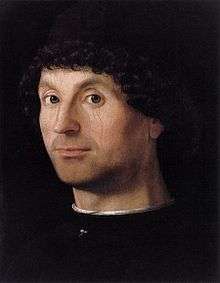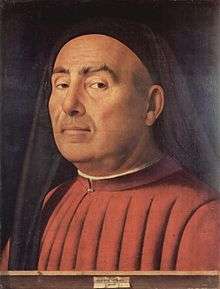Male portraits by Antonello da Messina
Portrait of a Man is the conventional title of several male portraits finished by the Italian Renaissance artist Antonello da Messina in the course of his career. These include:
Portrait of a Man (Pavia)

The picture, housed in the Town Museum of Pavia Lombardy, northern Italy, is signed according to the Flemish habit, by directly engraving the painter's name on the parapet in the lower foreground (instead of using a false glued panel), like the Madrid portrait. Despite the sign, the strict nearness to the Flemish portrait art and the poor state of preservation have pushed some scholars to doubt about the attribution to Antonello. The work has been dated to the 1460s basing on the fashion of the subject's dress and headgear.
Portrait of a Man (Madrid)

This portrait, finished c. 1475, is housed in the Museo Thyssen-Bornemisza, in Madrid, Spain. Among Antonello's portraits, it is among the most expressively animated ones. The subject, a young man, is drawn from a quite near point of view, with the usual skill in details rendering.
The picture has been approximately dated to the early 1470s, basing on the typical "zuccotto" headgear, a fashion more characteristic of 1460s Italy.
Portrait of a Man (Turin)

Often called the Trivulzio portrait, this portrait is housed in the Turin City Museum of Ancient Art. It was signed by Antonello and dated 1476. It was part of the collection of the Florentine noble family Rinuccini, which was later acquired by the Trivulzio. In 1935 the collection was scattered, although most of the material went to Milan. The Turin museum obtained this portrait and the Turin-Milan Hours.
Portrait of a Man (London)

Portrait of a Man is a painting by Italian Renaissance artist Antonello da Messina, currently housed in the National Gallery of London, United Kingdom. It was printed on the Italian 5,000 lire note issued from 1979 to 1983.
The work portrays an unknown man, whose garments belonged to the middle-upper class of the time. He wears a leather blouse, under which a white shirt is visible, and a red cloth beret.
He is depicted from three-quarters, differently from the tradition of the time. The dark background and the essential composition derived from Flemish painting school, including Petrus Christus, whom Antonello knew personally in Italy.
X-ray analysis proved that originally the eyes looked in a different direction. Perhaps there was a parapet with the signature, which was cut off later.[1] It has been suggested that this late work could be a self-portrait.[2]
Other portraits

- Portrait of a Man, (Berlin)
- Portrait of a Man, (Roma)
- The portrait usually known as The Condottiero, now in the Louvre of Paris
References
- ↑ Page at museum's official website
- ↑ De Vecchi, Pierluigi; Elda Cerchiari (1999). I tempi dell'arte. Milan: Bompiani. ISBN 88-451-7212-0.
Sources
- De Vecchi, Pierluigi; Elda Cerchiari (1999). I tempi dell'arte. Milan: Bompiani. ISBN 88-451-7212-0.
Further reading
- Barbera, K, ed. (2005). Antonello da Messina : Sicily's Renaissance master. New York: The Metropolitan Museum of Art.